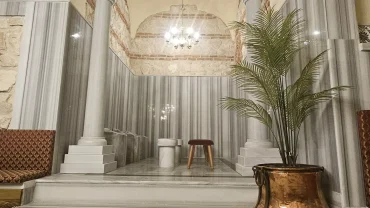The Turkish bath, or hamam, is not just a place for cleansing; it’s a sanctuary where the physical meets the spiritual, and the tradition dates back to the Roman times, later refined and embellished by the Ottomans. Embarking on a journey to a Turkish bath is a dive into a world of warmth, steam, and relaxation, an experience that rejuvenates the body and soothes the soul. This guide will navigate you through what to expect, the do’s and don’ts, the rituals to partake in, and the manifold benefits of this timeless tradition.
Before You Go: Preparation and What to Bring
Dress Appropriately: Most Turkish baths will provide you with a pestemal (a traditional cotton towel), slippers, and sometimes a kese (a rough mitt for scrubbing). However, wearing a swimsuit underneath your towel is advisable for comfort and modesty.
Timing is Key: Choose a time when you can unhurriedly soak in the experience. Early mornings or weekdays are usually less crowded.
Health Check: Ensure you’re well-hydrated and avoid heavy meals before your visit. If you have health concerns, consult with a doctor beforehand, especially regarding the intense heat.
Step-by-Step: The Rituals of a Turkish Bath
- Relaxing in the Warm Room: Your journey begins in the warm room (ılıklık), where you acclimatize to the heat, lying on heated marble platforms. This stage relaxes your muscles and opens your pores, preparing your body for the cleansing to come.
- The Hot Room: Next, you move to the hot room (sıcaklık). Here, the steam envelops you, and your body begins to sweat out toxins. You’ll lie on the göbek taşı, a central, heated marble slab, absorbing the warmth that radiates through your body, further loosening your muscles and pores.
- The Scrub: After soaking in the heat, a tellak (bath attendant) will scrub your body with a kese. This vigorous exfoliation removes dead skin cells, revealing soft, fresh skin beneath. It’s intense but incredibly refreshing.
- The Foam Massage: Following the scrub, comes a foam massage with a copious amount of soap suds. The tellak will use a special cloth to create the foam, enveloping you in a cloud of bubbles. This massage soothes the muscles and nurtures the skin, promoting relaxation and circulation.
- Rinsing and Washing: After the massage, you’ll be rinsed with warm water, washing away the foam along with any lingering stress and toxins.
- The Cold Plunge: To close the pores and invigorate the body, take a plunge into a cold pool if available. This contrast bath enhances circulation and boosts the immune system.
Post-Bath: Relaxation and Hydration
After the main rituals, wrap yourself in towels and proceed to the cooling-off area. Here, you can relax, sip on traditional Turkish tea, or even enjoy a light snack. It’s essential to rehydrate after the bath, so drink plenty of water.
The Benefits: Beyond Cleanliness
The Turkish bath offers myriad benefits, both physical and mental:
- Detoxification: The intense sweating helps flush toxins from the body.
- Improved Circulation: The heat and massage stimulate blood flow, enhancing circulation.
- Skin Health: The scrubbing removes dead skin cells, promoting healthy, glowing skin.
- Stress Relief: The warmth and massage can significantly reduce stress levels, promoting mental well-being.
- Immune Boost: The heat and subsequent cool plunge can strengthen the immune system.
Final Thoughts
A visit to a Turkish bath is an immersion into a world of historical tradition, offering a unique blend of relaxation, wellness, and cultural enrichment. By following the rituals and embracing the experience, you’ll walk away with not just cleansed skin, but a refreshed spirit and a deeper connection to a timeless practice. Whether you’re a seasoned spa-goer or a curious newcomer, the Turkish bath awaits to envelop you in its warm embrace, promising an unforgettable journey of rejuvenation.





Comment (0)